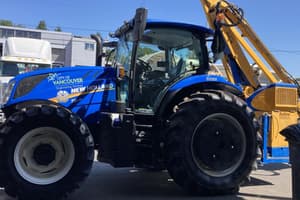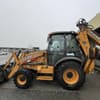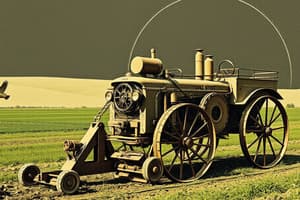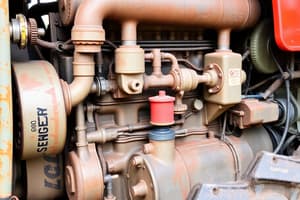Podcast
Questions and Answers
What is the primary purpose of maintaining proper housekeeping in a shop environment?
What is the primary purpose of maintaining proper housekeeping in a shop environment?
- To impress visitors
- To reduce the need for tools
- To optimize storage space
- To ensure safety and cleanliness (correct)
Which type of fire extinguisher is used for electrical fires?
Which type of fire extinguisher is used for electrical fires?
- Type K
- Type B
- Type A
- Type C (correct)
Which of the following is NOT a common biohazard?
Which of the following is NOT a common biohazard?
- Airborne dust (correct)
- Blood
- Manure
- Needles
What is a recommended action to prevent the buildup of harmful vapors?
What is a recommended action to prevent the buildup of harmful vapors?
What is the primary purpose of shop rules in an Ag Mechanics environment?
What is the primary purpose of shop rules in an Ag Mechanics environment?
Which type of fire extinguisher is suitable for combustible metals?
Which type of fire extinguisher is suitable for combustible metals?
Which of the following is NOT considered a common hazard on a job site?
Which of the following is NOT considered a common hazard on a job site?
What is the consequence of horseplay in the shop environment?
What is the consequence of horseplay in the shop environment?
Which materials would you use a Type K extinguisher on?
Which materials would you use a Type K extinguisher on?
What should be done immediately in the event of cuts and punctures?
What should be done immediately in the event of cuts and punctures?
If a tool breaks in the shop, what should you do?
If a tool breaks in the shop, what should you do?
What type of personal protective equipment (PPE) is recommended to avoid electrical shock?
What type of personal protective equipment (PPE) is recommended to avoid electrical shock?
Which of the following hazards can cause significant eye damage?
Which of the following hazards can cause significant eye damage?
What precaution should be taken to avoid slips and falls in a workshop?
What precaution should be taken to avoid slips and falls in a workshop?
What is a necessary action when dealing with hazardous chemicals?
What is a necessary action when dealing with hazardous chemicals?
Which of the following is an example of a crush hazard?
Which of the following is an example of a crush hazard?
Flashcards
Importance of Safety
Importance of Safety
Following established rules to protect individuals and equipment, and promote skills.
Flying Object Hazard
Flying Object Hazard
Objects that can be propelled through the air, like sparks or sawdust.
Chemical Exposure Hazard
Chemical Exposure Hazard
Harmful interaction with substances like acids, solvents, or gasoline.
Burn Hazards
Burn Hazards
Signup and view all the flashcards
Cuts and Punctures Hazard
Cuts and Punctures Hazard
Signup and view all the flashcards
Electrical Shock Hazard
Electrical Shock Hazard
Signup and view all the flashcards
Slips and Falls Hazard
Slips and Falls Hazard
Signup and view all the flashcards
Compressed Air Injuries
Compressed Air Injuries
Signup and view all the flashcards
Biohazards
Biohazards
Signup and view all the flashcards
Explosion Hazards
Explosion Hazards
Signup and view all the flashcards
Type A Fire
Type A Fire
Signup and view all the flashcards
Type B Fire
Type B Fire
Signup and view all the flashcards
Type C Fire
Type C Fire
Signup and view all the flashcards
Type D Fire
Type D Fire
Signup and view all the flashcards
Type K Fire
Type K Fire
Signup and view all the flashcards
Safety Practices
Safety Practices
Signup and view all the flashcards
Study Notes
Importance of Safety in Ag Mechanics
- Safety is crucial; good habits stem from following established rules.
- Shop rules aim to protect individuals, equipment, and promote skill development.
- Encourages respect for tools and fosters a positive shop environment through proper behavior.
Hazards on the Job Site
- Common hazards include:
- Flying Objects (sparks, debris, sawdust)
- Chemical exposure (acids, solvents, gasoline)
- Burns (first, second, and third-degree)
- Cuts and punctures (from metal, wire, welding rods)
- Electrical shock (ensure use of rubber-soled shoes and proper insulation)
- Slips and falls (caused by damp floors and poor footwear)
- Compressed air injuries (risk to eyes and ears)
- Biohazards (needles and organic matter)
- Explosions (due to improper container handling and pressure build-up)
Types of Fires
- Fire types categorized as:
- Type A: Wood, paper, cloth
- Type B: Flammable liquids (grease, oil, solvents)
- Type C: Electrical fires
- Type D: Combustible metals (e.g., magnesium)
- Type K: Cooking-related fires (animal fat, cooking oil)
- Knowledge of fire extinguisher types and locations is essential.
Safety Practices
- Maintain good ventilation to prevent harmful vapor build-up; employ fans or open doors.
- Housekeeping needs includes regular cleaning and proper tool storage.
- Common sense and attention to safety lead to fewer accidents; avoid horseplay.
- Personal Protective Equipment (PPE) is mandatory; incorrect usage leads to penalties.
Tool Guidelines
- Know how to properly use tools; testing may be required to ensure competence.
- Tools should only be used for their intended purpose and maintained in good working condition.
- Report any equipment malfunctions immediately.
General Conduct
- Avoid destruction of property; this includes damaging tools or inappropriate drawings.
- Every individual must maintain a clean workspace reflective of safety standards.
- Take time with tasks; rushing may lead to accidents.
Studying That Suits You
Use AI to generate personalized quizzes and flashcards to suit your learning preferences.





